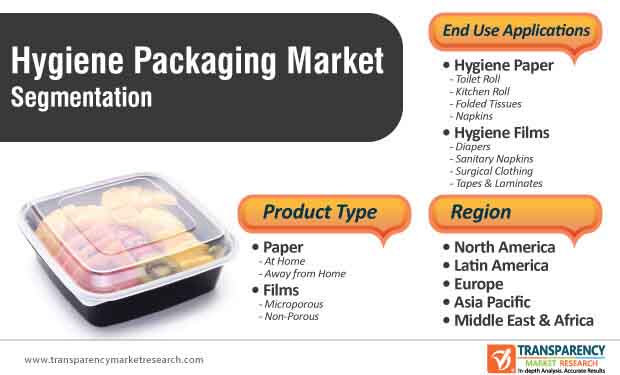
The packaging industry has witnessed a high volume growth during the coronavirus crisis. Better earning with the beginning of 2024 is anticipated to create value grab opportunities for companies in the hygiene packaging market, due to rising consumption of packed products. Companies such as Essel Propack, Cosmo Films, and Uflex are capitalizing on this opportunity to introduce hygiene packaging for liquid hand washes, sanitizers, and foods.
Manufacturers in the hygiene packaging market are increasing the availability of flexible packaging solutions, due to hazards associated with non-packaged products. A multifold increase in demand for personal hygiene products is anticipated to create stable and long-term revenue streams for manufacturers. Essential items such as edible oils, flour, and rice have opened up avenues for hygiene packaging. As such, single use food packaging is also on the rise.
Moreover, people are demanding antibacterial hygiene packaging products for fulfilling greater life expectancy. As per TMR findings, the global tissue paper and hygiene films consumption is expected to increase rapidly by 20-25% post pandemic situation. This can be attributed to changing hygienic understanding among consumers and reducing risk of infection during pandemic. However, every industry, including packaging, has witnessed the impact of the pandemic. From raw material supply delay to lockdown across various geographic locations, the industry is facing several challenges of elevated costs, pressure on prices, labor issues, and operational challenges.

Request a sample to get extensive insights into the Hygiene Packaging Market
Can Plastic be Entirely Omitted from Hygiene Food Packaging?
Plastic packaging delivers economic benefits companies in the hygiene packaging market. Plastic is associated with resource efficiency, since it increases the shelf life of food products, decreases food wastage, and its low weight attributes significantly cut down on fuel consumption during goods transportation. However, plastic is infamous for causing long-term environmental damages and leads to issues of decomposition. Hence, manufacturers in the hygiene packaging market are investigating composite materials such as paperboard combined with a small amount of plastic to minimize climate impact as compared to conventional all-plastic packaging.
In the area of food packaging, companies are replacing plastic trays with renewable paperboard as an easy alternative to plastic. As such, plastic is being linked to high hygiene requirements. Hence, companies are designing packaging trays with paperboard made from wood fibers and plastic barrier layer to meet hygiene packaging requirements.
To understand how our report can bring difference to your business strategy, Ask for a brochure
Brands Adopting Anti-microbial Packaging Drive Enormous Progress in Purchase of Products
The onset of the COVID-19 pandemic has drawn increased emphasis on hygiene packaging. Manufacturers are increasing their production capabilities in anti-microbial materials, tamper evident packaging, and use of ultraviolet light to comply with new packaging standards. Anti-microbial materials consisting of anti-microbial coating on plastic is gaining popularity as a cutting-edge development to kill bacteria by making the surface inhospitable. Companies in the hygiene packaging market are incorporating anti-microbial additives in a variety of material forms to meet requirements of consumers.
Manufacturers in the hygiene packaging market are entering into strategic agreements with material suppliers to increase the availability of anti-microbial coating solutions. These coating solutions are being made compatible with various paints, textiles, and plastics to make hygiene packaging easy and hassle-free. Brands adopting anti-microbial packaging solutions are sure to witness enormous progress in the purchasing of food and other products.
Read Our Latest Press Release:





